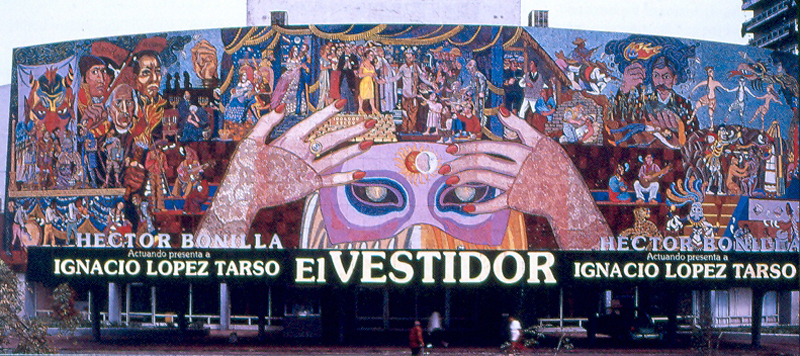
Diego Rivera (36) |
 |
|---|
Source: WTL research files. Mosaic: "Popular History" (1953) on the façade of the Teatro de los Insurgentes, Mexico City. Biographical data 1952-1957: In 1952, Rivera creates a very controversial and inflammatory "peace painting"; in 1953, he creates this mural seen here and a number of others; in 1953, he accompanies Frida in her last public appearance in a demonstration against the C.I.A. involvement in the overthrow of the president of Guatemala, Jacobo Arbenz Guzmán, and he is readmitted to the Mexican Communist Party. In 1955, he contracts cancer and seeks a cure in Moscow, where he undergoes an operation and has chimotherapy. In 1956, he travels to Prague, Poland, East Germany, and East Berlin before returning to Mexico, where he surprisingly announces that he is a Catholic, and he compiles inventories for his collections at Anahuacalli and Frida Kahlo's collections in Coyoacán. In 1957, he paints, suffers a paralyzing attack of phlebitis, and dies of a heart attack in his studio in San Ángel, D.F. He is buried in the Rotunda de los Hombres Ilustres in the Panteón de Dolores in Mexico City. In his will he donated all his possessions to the Mexican nation. Comments: This work is in the style of "pop art". In it Rivera demonstrates his love of the comics and buffonery. The subject matter goes from Cortés to the internationally famous Mexican comic actor Cantinflas. Also, we see Aztec rituals and Christians symbols depicted in an irreverent vein. The artistic medium of mosaics contributes to the sense and effect because this mosaic mural glitters when the sun strikes it. The large faces above the conquistadors represent heroes of the Mexican War of Independence and the 19th century reform movement. To the left of the masked face and hands at the bottom we see scenes of Spanish colonial-era oppression, and on the right, once again, we see Aztec religious ceremonies. Humanities Question: What do you think about the hands, eyes, and mask of the masked woman at the bottom center? (Hint: the symbol between the masked eyes is the sun-moon Hindu symbol of karma. ) What is your sense of this work coming near the end of Rivera's life and complete works? |
|---|
 |